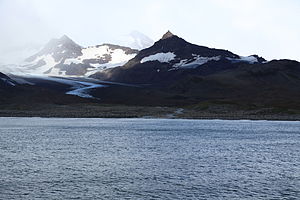St Andrews Bay, South Georgia

Saint Andrews Bay is a bight 2 miles wide, indenting the north coast of South Georgia immediately south of Mount Skittle. It was probably first sighted by the British expedition under James Cook which explored the north coast of South Georgia in 1775.
The name “St Andrews Bay” dates back to at least 1920 and is now well established.
King Penguins form huge breeding colonies - and the one at St Andrews Bay has over 100,000 birds. Because of the long breeding cycle, colonies are continuously occupied.
Ross Glacier which is nearby is retreating, and leaving a gravel beach in its wake. Heaney Glacier and Cook Glacier also are in the vicinity.